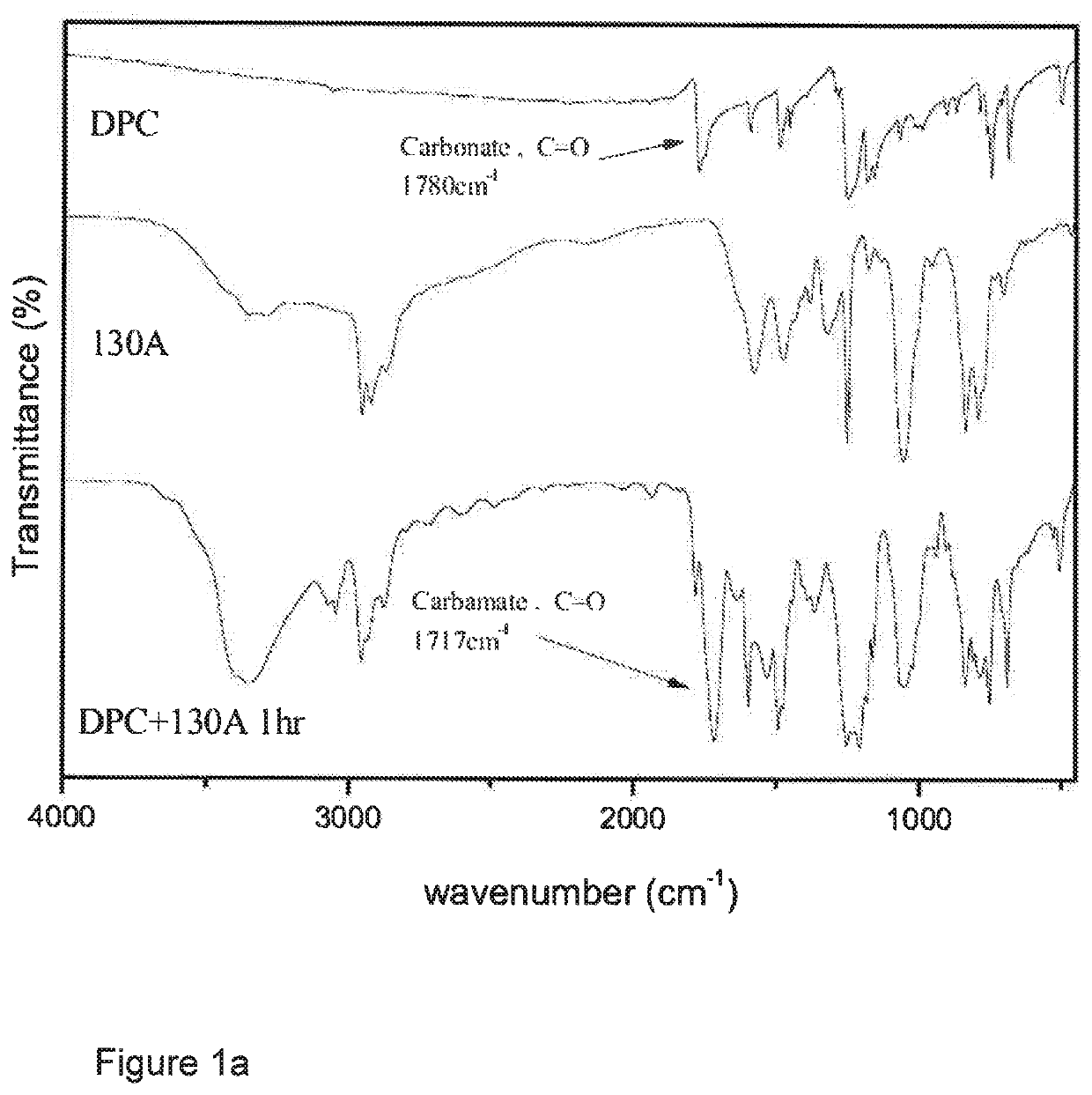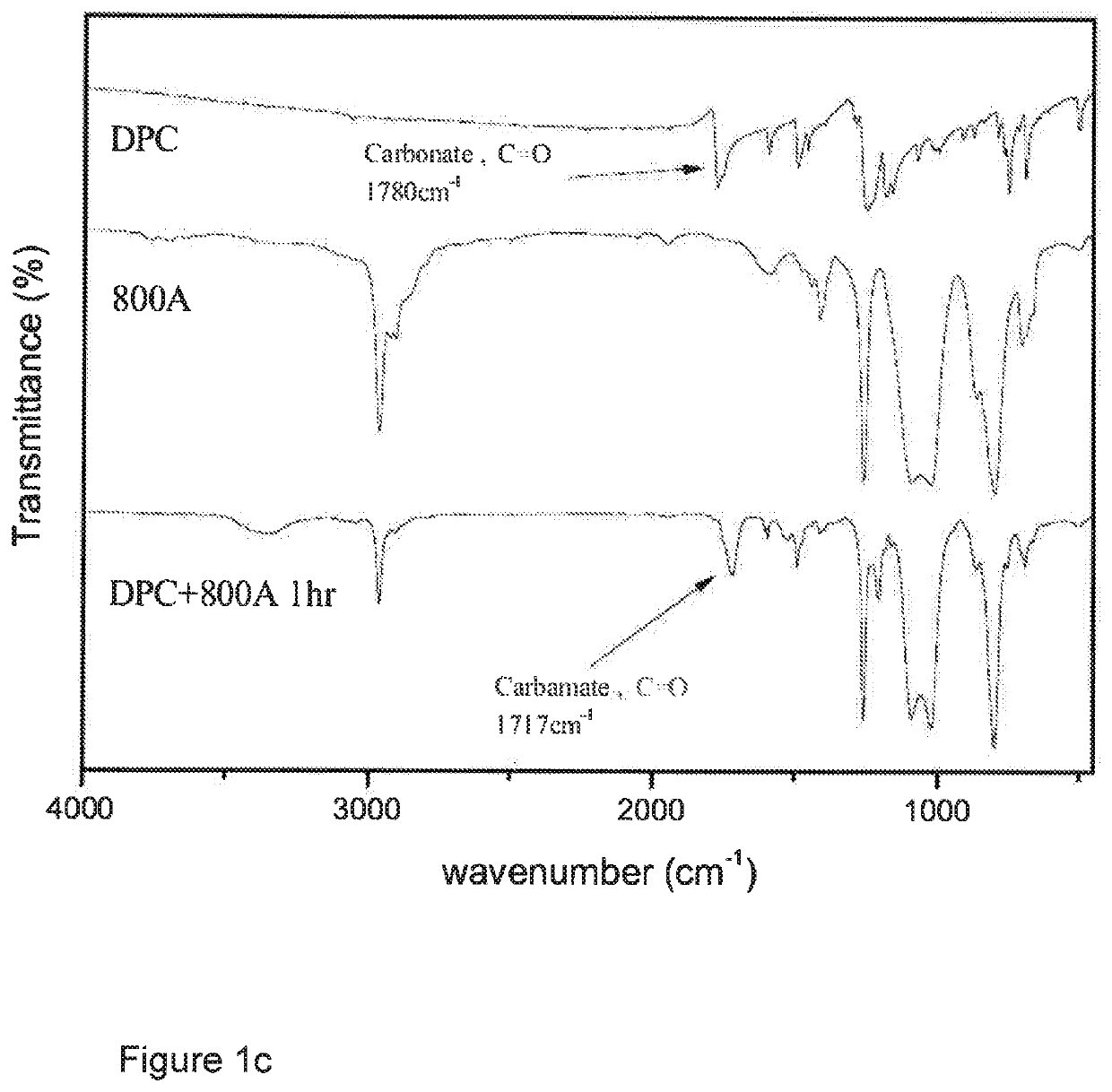Multi-functional carbamate having soft-segments, polyisocyanate obtained via subsequent non-phosgene synthesis methods, urethane prepolymer and elastomeric urethane having soft-segments derived therefrom, and preparation method thereof
a carbamate and multi-functional technology, applied in the preparation of carbamic acid derivatives, chemistry apparatus and processes, organic chemistry, etc., can solve the problems of high toxicity of phosgene, unavoidable shortcomings of phosgene method, damage to production equipment, etc., to improve physical and/or chemical properties, good chemical resistance, and high hydrophobicity
- Summary
- Abstract
- Description
- Claims
- Application Information
AI Technical Summary
Benefits of technology
Problems solved by technology
Method used
Image
Examples
example 1
of a Biscarbamate Having a Siloxanyl Group in its Backbone
[0160]A 150 ml round-bottom three-neck reactor was used, into a neck of which was inserted a thermometer, and nitrogen was introduced therethrough. Another neck was fitted with a condensation tube into which cold water was introduced for condensation. A third neck was plugged with a glass stopper so that it could be opened at times for sampling to monitor the reaction by IR. 84.45 g (0.394 mol) of diphenyl carbonate (DPC) was added to the reactor and heated to 80° C. until it melted and became a liquid. 50 g (0.192 mol) of 130 A diamine was dropwise and slowly introduced via a feed tube, and the mixture was mixed by vigorous magnetic stirring in the absence of a solvent, and reacted for 1 hr. at a temperature controlled at 80° C., during which the decrease of intensity of a carbonate absorption peak at 1780 cm−1 in the reactant and the increase of, and eventually constant, intensity of a polyurethane absorption peak at 1717 c...
example 2
of a Diisocyanate Having a Siloxanyl Group in its Backbone
[0163]The condensation tube in the apparatus used in the synthetic experiment in Example 1 was removed from the reactor, and replaced with a combined distillation tube (fitted with a thermometer). At one end of the tube, a one-neck flask was connected for receiving the by-product phenol produced during cracking. Then, a vacuum pump was connected, such that the cracking reaction was carried out with rapid stirring at a reduced pressure (7 cmHg). The reaction temperature was raised to 170° C. for 2 hrs., and the 130C / 430C / 800C biscarbamates synthesized above were cracked into products mainly characterized by isocyanate functional groups, which were 130I / 430I / 800I respectively. During the reaction process, the by-product phenol produced via decomposition was collected at the same time, and the cracking reaction was monitored by IR spectroscopy, until the absorption peak of the biscarbamate (at 1717 cm−1) disappeared, and the int...
example 3
of a Polyurethane Having a Siloxanyl Group in its Backbone (Isocyanate: 130I; and Chain Extender: IPDI)
[0168]A disconnecting-type 150 ml four-neck round-bottom flask was used; a right central neck of which was fitted with a mechanically stirred reactor, into another neck of the reactor was inserted a thermometer and nitrogen was introduced therethrough. Yet another neck was fitted with a condensation tube into which cold water was introduced. A fourth neck was plugged with a glass stopper, so that a small amount of sample could be taken out for monitoring the progress of reaction if needed. 23 g of toluene was added as a solvent to the round-bottom flask, then 1.35 g of excessive butanediol (BDO) and 6.45 g of 130I were added, and a drop of T9 was added, and the mixture was reacted at 80° C. for 1 hr. The reaction of 130-I with BDO to form a prepolymer having a soft segment and containing a terminal hydroxyl group was determined to be complete by FT-IR. Subsequently, 2.22 g of IPDI ...
PUM
| Property | Measurement | Unit |
|---|---|---|
| temperature | aaaaa | aaaaa |
| time | aaaaa | aaaaa |
| temperature | aaaaa | aaaaa |
Abstract
Description
Claims
Application Information
 Login to View More
Login to View More - R&D
- Intellectual Property
- Life Sciences
- Materials
- Tech Scout
- Unparalleled Data Quality
- Higher Quality Content
- 60% Fewer Hallucinations
Browse by: Latest US Patents, China's latest patents, Technical Efficacy Thesaurus, Application Domain, Technology Topic, Popular Technical Reports.
© 2025 PatSnap. All rights reserved.Legal|Privacy policy|Modern Slavery Act Transparency Statement|Sitemap|About US| Contact US: help@patsnap.com



